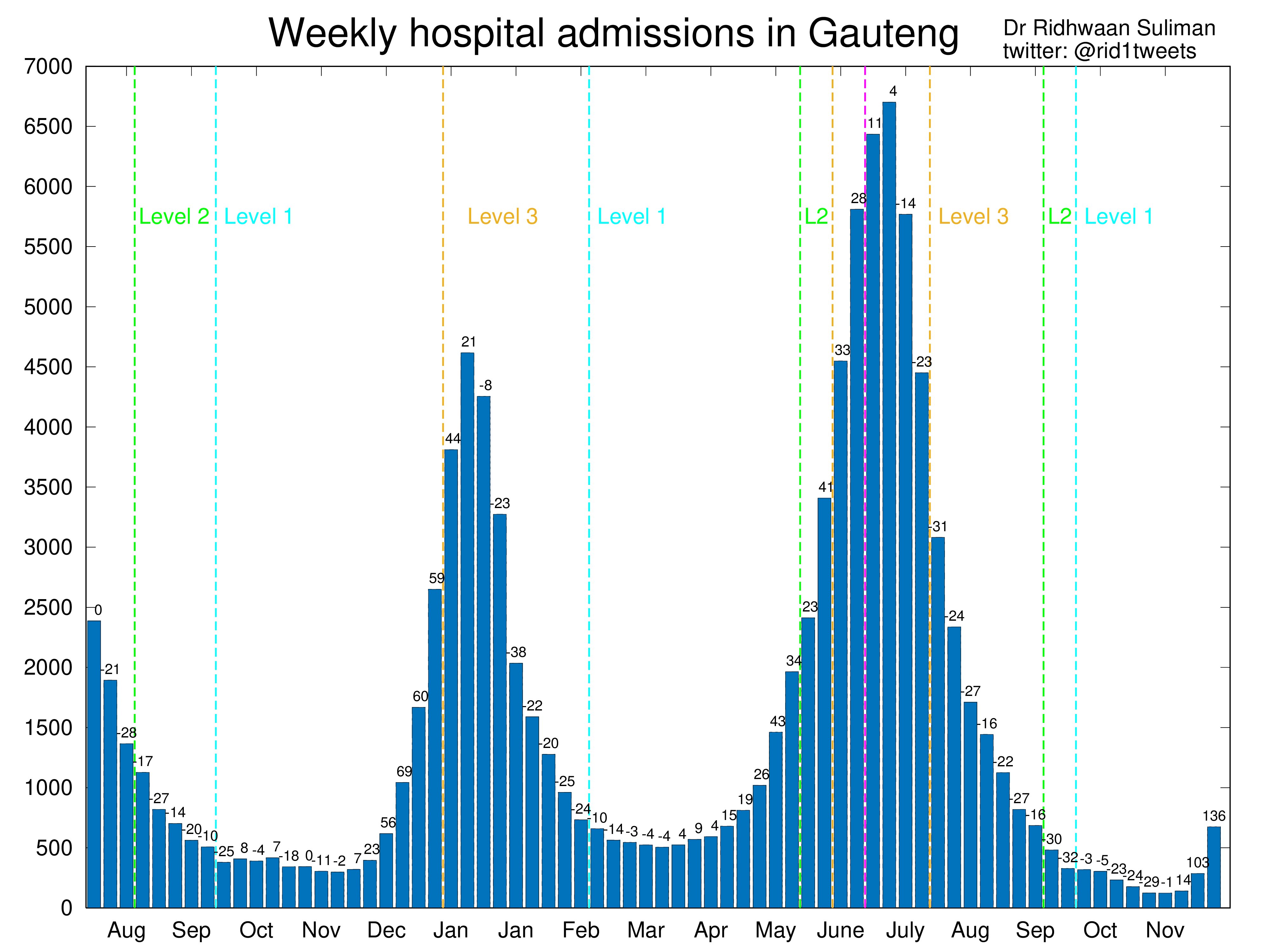Virus

- Posts : 3470
Join date : 2014-10-29
- Post n°951
 Re: Virus
Re: Virus
_____
you cannot simply trust a language model when it tells you how it feels

- Posts : 8095
Join date : 2020-09-07
- Post n°952
 Re: Virus
Re: Virus
lalinea wrote:nista me vise od vesti ne interesuje
_____

- Posts : 7233
Join date : 2019-11-04
- Post n°953
 Re: Virus
Re: Virus
A Variant Hunter on Omicron’s ‘Tectonic Shift’
By James D. Walsh
When virologist Jeremy Kamil got a look at the Omicron sequence posted to GISAID — an open-source website and global nonprofit that helps scientists share genome sequencing — shortly after the new variant was identified last week, it shocked him. Kamil, a professor of microbiology and immunology at Louisiana State University Health Shreveport, co-authored a study in February identifying seven lineages of the virus that cause COVID-19. He did so by analyzing changes to the virus’s spike protein: the macelike, studded surface of the coronavirus. Intelligencer asked Kamil what it is about Omicron that has virologists gobsmacked and why public-health officials are so concerned.
What was your reaction when you saw the Omicron sequence?
I was just totally shocked. It was like coming home to your front lawn after vacation and someone hasn’t just planted a couple of flowers in the flower bed — they’ve totally remodeled everything. It was a tectonic shift in the antigenic landscape.
How does Omicron compare with other variants you’ve seen over the past year?
This variant has a whole slew of mutations far beyond what has been observed in any other variant we’ve seen. Depending on how you define the receptor-binding domain, there are somewhere between ten and 15 mutations just in the receptor-binding domain alone, which is just outstanding. I think Alpha had something like eight mutations across the spike, and this has over 30 across the spike. So it has a whole lot of changes going on, and that’s a lot of the reason people are concerned. The immune response has been trained against the ancestral spike present in the vaccines, or, if you’ve been infected, your immune response is trained against whatever variant you were infected by, which would be Delta for a lot of people. The only modest silver lining is that Omicron has at least a couple of changes in common with Delta. If someone did develop antibodies from a Delta breakthrough infection or a Delta infection, they may have some cross-protection against Omicron.
How long are we talking about until we know how protected we are?
Public-health authorities are telling us about two weeks. That sounds somewhat realistic because people are basically going to have to print synthetic DNA. What they do first is use these things called pseudo-viruses. They’ll take something called a lentiviral vector, and they’ll use the spike protein of Omicron to pseudotype it so it uses Omicron’s entry machinery instead of the natural HIV entry machinery. They’ll test serum from people who’ve been vaccinated or who have recovered from coronavirus disease, and they’ll look and see how well that neutralizes.
It’s a very valuable experiment to do even though it can be a little bit crude. The best experiments will be with actual Omicron-variant coronavirus. But that has to be grown up, and at biosafety-level-three labs, it’s harder to do that work because there are more precautions and less lab space. Pseudotype experiments can happen at biosafety-level two, which is what most research labs in the U.S. are.
So how concerned should we be about breakthrough infections at this point?
Due to how extensively mutated the spike gene is in this variant, there’s good reason to be concerned about breakthrough infections. We already saw a lot of breakthrough infections with Delta, and you’d expect this critter to be more evasive than Delta. The good news for Delta was that even if there were breakthroughs, we knew that the severity of the infection was usually far less in people who were vaccinated. The reason people are more concerned with Omicron is that we don’t know what the disease is going to look like even in vaccinated people.
I do think there are reasons to be optimistic. Some people are saying, “Hey, we’re back at square one.” That’s not really true. We have mRNA-vaccine platforms. We know that masking works. If you go back to March 2020, there was so much unknown. We were locking down playgrounds. We’re not back there. I think it’s just a sobering moment in which we have to remind ourselves that we’ve never moved through a pandemic of a coronavirus before. There’s nothing certain in human history about this. We know from seasonal coronaviruses that those probably started out as pandemics, but we don’t know for sure what it was like to live through one of those. We don’t know how many waves to expect. There are more human beings on the planet now than there ever were before, which means there are more potential hosts to drive rapid evolution of this virus.
A South African doctor, who was one of the early doctors to suspect a new variant, has described symptoms in patients as “very mild.” Is that anecdotal evidence worth much at this point?
I saw someone tweeted that. I even quote-tweeted it and said something snarky like, “Huge, if true,” but then I took it down because people didn’t realize I wasn’t being serious. It’s way too early to know. These cases, when they emerged in South Africa, they may have been people who had already survived a Beta infection, for instance. Or they may be younger. You don’t know from such small numbers. It would be great if it happens to be true that symptoms are mild.
If you talk to corona virologists, who are the real experts, they’ll tell you a lot of the biology comes down to the spike protein, and this spike is different enough from the ancestral spike that it’s not implausible that the disease characteristics might be different. However, I’d say that the safest thing to do is to presume for the time being that this is identical to Delta or Beta or Gamma or the ancestral Wuhan virus in terms of the danger of being infected by it. It’s something to be concerned about. It’s safe to presume that this is just as bad as getting the virus in 2019 until we have proof otherwise. We shouldn’t panic, but we should be careful. I wouldn’t go to a karaoke lounge right now or even a crowded bar.
...
https://nymag.com/intelligencer/2021/12/a-variant-hunter-on-omicrons-tectonic-shift.html

- Posts : 13817
Join date : 2016-02-01
- Post n°955
 Re: Virus
Re: Virus
https://www.vrt.be/vrtnws/de/2021/11/19/ungeimpfte-corona-patienten-sind-auf-der-intensivstation-ueberre/ (prevod: Deepl)In the last two weeks, about 20 unvaccinated Corona patients over age 65 per 100,000 population ended up in the ICU, but only 5 vaccinated. In the 18 to 64 year old group, 9 unvaccinated Corona patients per 100,000 population landed in the ICU in the past two weeks. In contrast, only one vaccinated Corona patient per 100,000 population received intensive care.
"The fully vaccinated ICU patients tend to be somewhat older," says Steven Van Gucht. "Mainly people over 70 with underlying diseases, while the non-vaccinated patients in the hospital are on average twenty years younger."

- Posts : 13817
Join date : 2016-02-01
- Post n°956
 Re: Virus
Re: Virus
https://newsnodes.com/omicron_tracker

- Posts : 13817
Join date : 2016-02-01
- Post n°957
 Re: Virus
Re: Virus
https://www.newyorker.com/news/q-and-a/how-south-african-researchers-identified-the-omicron-variant-of-covid
Evo detaljnog opisa kako je otkriven omikron:
When did you first have a sense of the existence of this new variant?
I am the principal investigator and leader of the Network for Genomic Surveillance in South Africa, which involves seven genomic facilities distributed across the country. There was an uptick of cases in Gauteng Province. It was only a small uptick—we had around two hundred cases in the whole country every day. But they started growing, and so we met with our network and said we needed to understand why they were growing in the province that had the largest previous wave of infections of Delta. That variant was extreme in Gauteng, with somewhere between sixty and eighty per cent of people having gotten infected by covid, according to serology testing.
So on Friday, November 19th, we decided that we needed to increase genomic surveillance in Gauteng. And by last Tuesday we heard from one member in our network that a private lab, Lancet Laboratories, had sent in six genomes of a very mutated virus. And, when we looked at the genomes, we got quite worried because they discovered a failure of one of the probes in the P.C.R. testing. We went back to all the national data and noticed this failure was increasing in a lot of the P.C.R. tests. The P.C.R. tests still worked because they had three probes, but one of them was a failure. And then we discussed the six genomes. We were surprised, but we had to make sure it wasn’t just a small chain of transmission. It was widespread. So we had that meeting last Tuesday, and I asked for samples from other labs.
When I noticed that mutated variant on Tuesday, I phoned the director general of health, and he told me he would set up a meeting with me and the minister of health in thirty-six hours. So we had thirty-six hours to confirm whether it was real. At the same time I wrote to the World Health Organization, because I am a part of the virus-evolution working group. The next morning, we got over a hundred samples from over thirty clinics in Gauteng, and we started genotyping, and we analyzed the mutation of the virus. We linked all the data with the P.C.R. dropout, the increase of cases in South Africa and of the positivity rate, and then we began to see it might be a very suddenly emerging variant. By Thursday morning we got all the genomes back, and they were all the same variant—around a hundred randomly selected samples, from all over Gauteng, in which the same test failed. By then I was confident enough to present the results to our minister of health, and minister of science and innovation, who took the results quite seriously and asked me to talk to the President, Cyril Ramaphosa, at half past 10 a.m., which I did.
What was that conversation like?
He looked at the results and got the comments from the ministers, and by that time the first reports were coming in the media of a potential new variant from Southern Africa. So the President gave a simple answer: it is better that we present it in a transparent format, because we have enough evidence. And then he asked the minister of health to organize a press briefing at midday. So the time from when we discovered the variant and then confirmed its existence in hundreds of samples across the province to when we presented it to key ministers and talked to the President and went public with it was around thirty-six hours.

- Posts : 13817
Join date : 2016-02-01
- Post n°958
 Re: Virus
Re: Virus

What about hospitalisations in Gauteng?
— Ridhwaan Suliman (@rid1tweets) December 1, 2021
New admissions increased by 144% last week or doubling about every 6 days
Remember: hospitalisations lag cases by 1-3 weeks, and with reporting delays need to wait a week to understand actual hospital admissions for previous week... pic.twitter.com/7eVbr3mk6e
% difference between week_t and week_t-1
— rapha (@raphaludwig) December 1, 2021

- Posts : 15555
Join date : 2016-03-28
- Post n°959
 Re: Virus
Re: Virus
https://www.reddit.com/r/Coronavirus/comments/r6v00d/50_suspected_omricon_cases_in_norway_after_a/
_____
Što se ostaloga tiče, smatram da Zapad treba razoriti
Jedini proleter Burundija
Pristalica krvne osvete

- Posts : 13817
Join date : 2016-02-01
- Post n°960
 Re: Virus
Re: Virus
There was an uptick of cases in Gauteng Province. It was only a small uptick—we had around two hundred cases in the whole country every day. But they started growing, and so we met with our network and said we needed to understand why they were growing in the province that had the largest previous wave of infections of Delta. That variant was extreme in Gauteng, with somewhere between sixty and eighty per cent of people having gotten infected by covid, according to serology testing.
Dakle, kad ukrstimo šta je De Oliveira rekao i ovaj grafikon hospitalizacija, imamo rekordan porast hospitalizacija u pokrajini u kojoj je između 60% i 80% ljudi već preležalo deltu ili neki od ranijih sojeva i u kojoj je potpuno vakcinisano 23% stanovništva* (16% dvodoznim vakcinama, uglavnom Fajzerom, i 7% jednodoznom J&J vakcinom). Nikako ne izgleda dobro.
Gauteng ima 15,8 miliona stanovnika, najmanje jednom dozom vakcinisano je 4,36 miliona, 3,6 miliona je potpuno vakcinisano, a jednodozni J&J primio je 1,1 milion stanovnika.
https://sacoronavirus.co.za/latest-vaccine-statistics/

- Posts : 13817
Join date : 2016-02-01
- Post n°961
 Re: Virus
Re: Virus
disident wrote:Aj da uzmem sa zrnom soli jer ne mogu da proverim izvor
https://www.reddit.com/r/Coronavirus/comments/r6v00d/50_suspected_omricon_cases_in_norway_after_a/
Ima ovde link na norveški članak o tome koji se vidi ceo i može se prevesti GT-om. Piše 30-40 sumnjivih (dosad) od 120 prisutnih.
https://coronashock.blogspot.com/2021/12/suspected-b11529-omicron-spread-at.html
Last edited by rumbeando on Thu Dec 02, 2021 12:31 pm; edited 1 time in total

- Posts : 13817
Join date : 2016-02-01
- Post n°963
 Re: Virus
Re: Virus
Now that some previous omicron cope has expired (it does seem to be growing faster, it's not just in South Africa) the main game in town is the m-word. Is it milder? But I think that's tricky to work out, particularly at the moment.
— Oliver Johnson (@BristOliver) December 2, 2021
2. In order to determine whether it's milder, you need some confidence in what fraction of infections or cases lead to hospitalization. But this gets into questions of lag: how long from case to admission, when you try to line up the two time series against each other.
— Oliver Johnson (@BristOliver) December 2, 2021
4. Whereas in South Africa, where cases are growing something like 500% per week (30% per day!) if you misestimate the lag by a couple of days in either direction, your estimate of "fraction hospitalized" might be out by 70% or more in either direction.
— Oliver Johnson (@BristOliver) December 2, 2021
6. Honestly, it's a complicated mess, and I think (boring answer) we need to wait for more data based on actually tracking particular patient outcomes before coming to any firm conclusions.
— Oliver Johnson (@BristOliver) December 2, 2021

- Posts : 13817
Join date : 2016-02-01
- Post n°964
 Re: Virus
Re: Virus
https://www.timesofisrael.com/liveblog_entry/s-africa-expert-previous-infection-doesnt-protect-against-omicron-but-shots-do/
People infected with earlier variants of COVID-19 do not appear to be protected against Omicron, but vaccination will prevent serious illness, a top South African scientist says.
“We believe that previous infection does not provide protection from Omicron,” says Anne von Gottberg, an expert at the National Institute for Communicable Diseases.
Outlining early research into the newly emerged variant, she says doctors are seeing “an increase for Omicron reinfections.”
“We believe the number of cases will increase exponentially in all provinces of the country,” she says. “We believe that vaccines will still, however, protect against severe disease.”

- Posts : 13817
Join date : 2016-02-01
- Post n°965
 Re: Virus
Re: Virus
The number of countries reporting SARS-CoV-2 Omicron variant of concern (VOC) cases continues to increase globally, with a total of 352 confirmed cases reported by 27 countries as of 16.00 on 1 December 2021, including 70 confirmed cases reported by 13 European Union and European Economic Area (EU/EEA) countries. The majority of confirmed cases have a history of travel to southern African countries, with some having taken connecting flights at other destinations between Africa and Europe. Several European countries have already reported subsequent community or household transmission. All cases for which there is available information on severity were either asymptomatic or mild. To date, there have been no severe cases and no deaths reported among these cases.
Current evidence on transmissibility, severity, and immune escape is highly uncertain for the Omicron VOC. However, preliminary data from South Africa suggest that it may have a substantial growth advantage over the Delta VOC. If this is the case, mathematical modelling indicates that the Omicron VOC is expected to cause over half of all SARS-CoV-2 infections in the EU/EEA within the next few months. The greater Omicron's growth advantage over the Delta VOC and the greater its circulation in the EU/EEA, the shorter the expected time until the Omicron VOC causes the majority of all SARS-CoV-2 infections.
The presence of multiple mutations in the spike protein of the Omicron VOC indicates a high likelihood of reduction of neutralising activity by antibodies induced by infection or vaccination. Preliminary data suggest that the Omicron VOC may be associated with increased risk of reinfection in South Africa. However, the full extent to which the Omicron VOC evades or erodes existing vaccine- or infection-derived immunity remains uncertain in the absence of in vitro neutralisation data, vaccine effectiveness data, and further data on reinfection in populations exposed to different SARS-CoV-2 variants during previous pandemic waves.

https://www.ecdc.europa.eu/sites/default/files/documents/threat-assessment-covid-19-emergence-sars-cov-2-variant-omicron-december-2021.pdfThese results depend on many still unknown factors about transmissibility, vaccine immunity escape, natural immunity escape, and others. In addition to the ongoing Delta VOC resurgence in October-November 2021, these unknown factors underline the importance of (more stringent) NPIs [non-pharmaceutical interventions], continued high vaccine uptake, and booster doses.

- Posts : 7775
Join date : 2017-03-14
- Post n°966
 Re: Virus
Re: Virus
e u pmrumbeando wrote:
https://www.timesofisrael.com/liveblog_entry/s-africa-expert-previous-infection-doesnt-protect-against-omicron-but-shots-do/
People infected with earlier variants of COVID-19 do not appear to be protected against Omicron, but vaccination will prevent serious illness, a top South African scientist says.
“We believe that previous infection does not provide protection from Omicron,” says Anne von Gottberg, an expert at the National Institute for Communicable Diseases.
Outlining early research into the newly emerged variant, she says doctors are seeing “an increase for Omicron reinfections.”
“We believe the number of cases will increase exponentially in all provinces of the country,” she says. “We believe that vaccines will still, however, protect against severe disease.”

- Posts : 13817
Join date : 2016-02-01
- Post n°967
 Re: Virus
Re: Virus
Germany's leaders impose stringent nationwide restrictions on people who aren't vaccinated and back a plan to make Covid shots compulsory https://t.co/ACBF8ecNZp
— Bloomberg (@business) December 2, 2021
https://www.bloomberg.com/news/articles/2021-12-02/germany-imposes-strict-curbs-on-unvaccinated-to-stem-covid-surgeIn one of her final acts as chancellor, Angela Merkel held talks with her incoming successor, Olaf Scholz, and Germany’s 16 regional premiers on Thursday, where they agreed on new curbs including allowing only people who are vaccinated or recovered into restaurants, theaters and non-essential stores.
The officials also backed a plan to make Covid shots mandatory, saying that the lower house of parliament would vote on it soon. Scholz said he expects the measure to pass, and Merkel -- who is stepping down from all of her political posts -- said she would vote for it if she was in the Bundestag.

- Posts : 7775
Join date : 2017-03-14
- Post n°968
 Re: Virus
Re: Virus
13.74MNE wrote:15.35MNE wrote:
15.74
15.97
13.66
14.6
9.56
16.25
16.02
14.54% prosjek, pad za skoro 35%, mislim da ovakav pad još nije bio
15.08
13.61
13
16.54
13.87
13.22
14.38% prosjek, pad za 1% tj. u okviru statističke greške, mada sa ovim procentom imam osjećaj da možemo da guramo godinama ovako
inače izgleda da su nevakcinisani skoro svi preležali pa se sada prijavljuje više vakcinisanih zaraženih (što je i logično jer im ispari imunitet pogotovo kinezima) i antivakseri već prave jesamtireko postove na fb
12.05
12.75
12.19
15.87
12.88
12.19
13.09% prosjek, pad za skoro 10%

- Posts : 37661
Join date : 2014-10-27
- Post n°969
 Re: Virus
Re: Virus
_____
And Will's father stood up, stuffed his pipe with tobacco, rummaged his pockets for matches, brought out a battered harmonica, a penknife, a cigarette lighter that wouldn't work, and a memo pad he had always meant to write some great thoughts down on but never got around to, and lined up these weapons for a pygmy war that could be lost before it even started

- Posts : 13817
Join date : 2016-02-01
- Post n°970
 Re: Virus
Re: Virus
BREAKING—New domestic-travel only #Omicron case identified in Minnesota of a travelers who visited New York City and attended an anime convention at the Javits Center Nov 19-21, and got symptoms on Nov 22nd.
— Eric Feigl-Ding (@DrEricDing) December 2, 2021With such timeline, it could be now across US. https://t.co/nCESkrLkIe pic.twitter.com/4k4fQmr8wl

Last edited by rumbeando on Thu Dec 02, 2021 5:53 pm; edited 2 times in total

- Posts : 52540
Join date : 2017-11-16
- Post n°971
 Re: Virus
Re: Virus
boomer crook wrote:uz opasnost da antropomorfizujem nesto sto nije ni zivo bive kao da se virus bori protiv svojih prethodnih iteracija a ne protiv vakcine. ono staljin vs trocki.
Khm


- Posts : 52540
Join date : 2017-11-16
- Post n°972
 Re: Virus
Re: Virus
rumbeando wrote:Germany's leaders impose stringent nationwide restrictions on people who aren't vaccinated and back a plan to make Covid shots compulsory https://t.co/ACBF8ecNZp
— Bloomberg (@business) December 2, 2021
https://www.bloomberg.com/news/articles/2021-12-02/germany-imposes-strict-curbs-on-unvaccinated-to-stem-covid-surgeIn one of her final acts as chancellor, Angela Merkel held talks with her incoming successor, Olaf Scholz, and Germany’s 16 regional premiers on Thursday, where they agreed on new curbs including allowing only people who are vaccinated or recovered into restaurants, theaters and non-essential stores.
The officials also backed a plan to make Covid shots mandatory, saying that the lower house of parliament would vote on it soon. Scholz said he expects the measure to pass, and Merkel -- who is stepping down from all of her political posts -- said she would vote for it if she was in the Bundestag.
Lako je Nemcima, kod njih nije bitan ustav...

- Posts : 8696
Join date : 2016-10-04
- Post n°973
 Re: Virus
Re: Virus
Али наставак је још бољи:
" instead of shooting where I was, you should have shot where I was going to be! "
Важи и за вакцине и вирус.

- Posts : 28265
Join date : 2015-03-20
- Post n°974
 Re: Virus
Re: Virus

_____
#FreeFacu
Дакле, волео бих да се ЈСД Партизан угаси, али не и да сви (или било који) гробар умре.

- Posts : 7233
Join date : 2019-11-04
- Post n°975
 Re: Virus
Re: Virus
...
NPR spoke with two scientists in the thick of this research. Trevor Bedford is a computational virologist and professor at the Fred Hutchinson Cancer Research Center in Seattle. Richard Lessells is an infectious disease specialist at the University of KwaZulu-Natal in Durban, South Africa, and part of the team that identified omicron in South Africa and alerted the world. Here's what they have to say.
Omicron's genetic family tree contains a big surprise
One of the key tools that scientists use to puzzle out the origin of a particular coronavirus variant is to look at its genetic code. Just as people who want to find out their ancestry — were their forebears Nordic? Mongol? — can find traces of that lineage in their genes, the virus's genome contains clues.
"It's been very common to use an evolutionary tree — or a family tree — of these SARS-CoV-2 viruses to catch introductions in places like Australia and Taiwan that have not had a lot of local spread," says Bedford. "You can figure out where the importations are coming from by looking at the viral genome and checking, 'Is it close in its sequence characteristics to [strains] that are circulating elsewhere that have been sequenced and shared with the database?' "
Scientists can then see, as they continue to take samples in the new region over time, how each particular strain starts to pick up additional — often benign — mutations step by step until it morphs into a significantly different strain.
But Bedford says that when you look at the family tree for this omicron variant, there's something surprising: "With omicron, your closest sequences are back from mid-2020 — so over a year ago. That is very rare to see."
In other words, while scientists can tell that this variant evolved from a strain that was circulating in mid-2020, in the intervening months there has been no trace of all the intermediate versions that scientists would have expected to find as it morphed into its current form.
"It doesn't tie into anything that was circulating more recently," says Bedford." Yet its mutations put it a long way from that 2020 strain.
How to explain this?
Hypothesis No. 1: The animal source
It's possible, says Bedford, that the mid-2020 strain infected some unknown animal population, evolved as it spread among that population and has just recently spilled back over into humans.
But Bedford thinks that this hypothesis is unlikely to prove true. "This is getting technical," he says. But the gist is that you'd expect to see signs of the animal's genetic material in the genome, and instead there's an insertion of human RNA "that suggests that along [omicron's evolutionary] branch, it was evolving in a human."
Hypothesis No. 2: "Cryptic spread" in an unmonitored region
Another possibility, says Bedford, is that the mid-2020 strain started circulating in a location where there hasn't been a lot of monitoring — "perhaps somewhere in southern Africa." That would have enabled the virus to evolve under the radar all this time. "And eventually, by the time you get to 2021, it's picked up enough mutations that it has become [much more] transmissible and then kind of explodes onto the scene at that point," says Bedford.
But he also finds this scenario — which scientists sometimes refer to as "cryptic spread" — hard to believe. "Because it would seem that as [this strain of the virus] was on its path to becoming omicron and becoming a quite transmissible virus, [the earlier versions] would have started to spread more widely before just now." And at that point, those earlier strains would have been noticed in countries that do have robust surveillance systems.
Lessells agrees. On the one hand, he notes, there certainly are countries in Africa where there has not been much ongoing sampling of the coronavirus. Indeed, he says, earlier in the coronavirus pandemic, South Africa's labs picked up a variant that hadn't been seen before through testing a traveler from Tanzania, one of several sub-Saharan African countries "where they weren't measuring the epidemic very well."
"Now," he adds, "that variant, to our knowledge, never really took off in any area. And we still don't know to what extent that was circulating in Tanzania and what the significance of it was." But he says the episode — and others like it — illustrate that once a variant reaches South Africa, at least, it is least likely to get identified. "We have seven [genomic] sequencing hubs that are each connected to the public and private diagnostic labs across the country," he says.
Also, omicron in particular triggers a notable signature in the PCR tests that are being conducted on a routine basis to confirm infections. This warning flag, in fact, is what spurred a private lab to send the samples to Lessells and his colleagues, who, upon sequencing them, discovered the omicron variant. "If you've got representative sequencing and frequent sequencing, and if you can be nimble enough to respond to what you're observing in the cases in the diagnostic lab, then you can pick up these variants that are at a relatively early stage," he says. "So you'd have to have a pretty big blind spot to be missing something that's really evolving over a period of months."
Hypothesis No. 3: Incubation in an immunocompromised person
There is, however, one place the virus could have been hiding while it evolved into omicron that probably would have been in health officials' blind spot: inside the body of a single person. Specifically, a person whose immune system was suppressed — for example, as a result of an untreated HIV infection. In such instances, explains Bedford, the person's immune system is still strong enough to prevent the coronavirus from killing the person. But it's not strong enough to completely clear the virus. So the virus lingers inside the person for month after month, continually reproducing. With each replication, there's a chance it will acquire a mutation that makes it better at evading the person's antibody-producing immune cells.
"It creates this kind of cat-and-mouse game where the immune response is chasing and the virus is running," says Bedford. "And so over the course of the year, if you look in these individuals, you see, at the end of that time, generally a quite evolved virus."
Lessells is one of several researchers to have demonstrated this phenomenon by retroactively analyzing a series of coronavirus samples that had been taken over a period of about six months from a woman who had HIV. Through an unfortunate series of unintended mishaps in her medical care, it later transpired that she was not being properly treated for her HIV infection during that time — even as she was enrolled in a larger study for which samples were being taken of the coronavirus that she harbored.
"Because we had samples from a few different time points over that six-month period," says Lessells, "we could show how the virus evolved and variants with some of the same mutations as the variants of concern appeared over time in the samples."
If this is how omicron was created, then presumably it wasn't until fairly recently that the virus finally spread into others from the person who was incubating it.
Why wouldn't this spread have happened at earlier points during omicron's evolution in the immunocompromised individual's body?
"That's a good question and a legitimate one," says Bedford. "I don't have an obvious answer besides chance." Still, like Lessells, he currently considers this scenario the most plausible explanation for omicron's emergence.
Why knowing omicron's source matters
Both scientists stressed that the scientific investigation of omicron is happening in real time, with new information coming out so fast that their views on its origins could change.
Still, in the short run, says Bedford, making educated guesses as to omicron's source can help scientists assess the potential threat from the variant. For instance, he says, if omicron had been evolving out of sight in a large population of humans over a period of months, this suggests it's actually not that transmissible. After all, he says, "we've still only seen a handful of these travel cases [arriving in various countries]. So that would suggest that it hasn't been spreading really rapidly — that it's taken a little while to ramp up to this level."
But, he says, if omicron evolved in one person's body and only recently spread to a wider population, this means the level of circulation that is now being detected — or as Bedford puts it, "the time frame for getting to where we are now, where we're starting to pick up cases in travelers'' — was reached over a much shorter period. And this would suggest that the variant is much more transmissible.
The larger takeaway: Ramp up HIV treatment
Regardless of the origins of omicron, Bedford and Lessells say its emergence is one more reminder that dangerous future variants could be created by the mutation of the virus in an immunocompromised person. This is especially urgent when it comes to the millions of people in southern Africa who have HIV and are not on medication. The point is not to blame or stigmatize people in this situation, they say, but rather to recognize that helping them is a key to ending the coronavirus pandemic. As Lessells puts it: "The intervention here is clear. We just need to strengthen our HIV response and get as many people as we possibly can onto effective treatment regimens."



 by lalinea Wed Dec 01, 2021 8:33 pm
by lalinea Wed Dec 01, 2021 8:33 pm